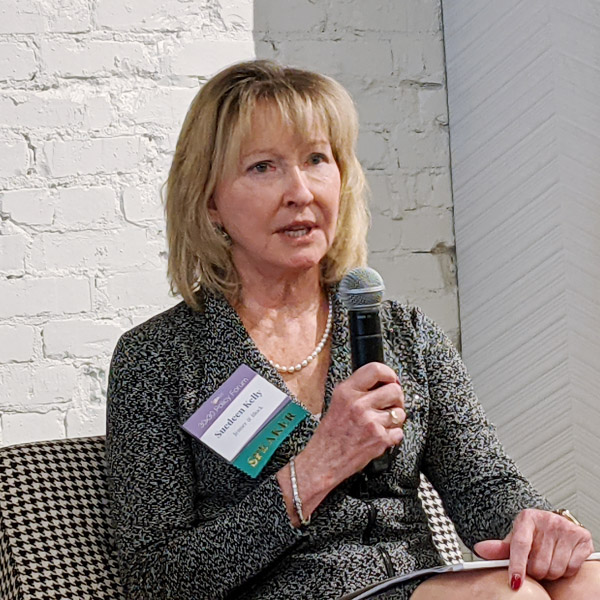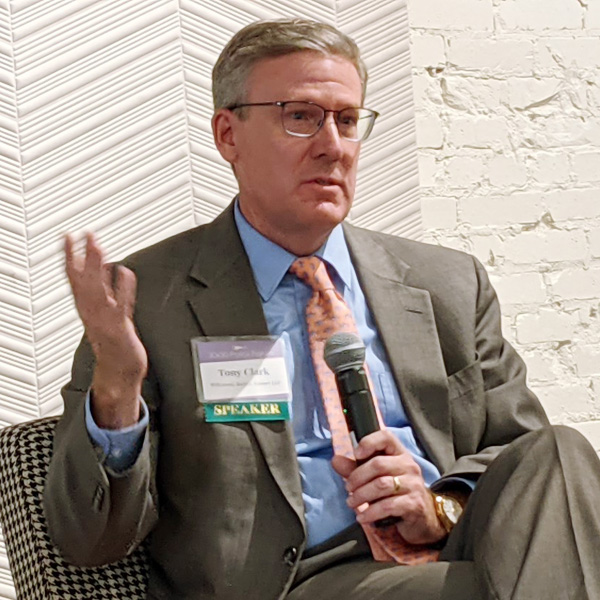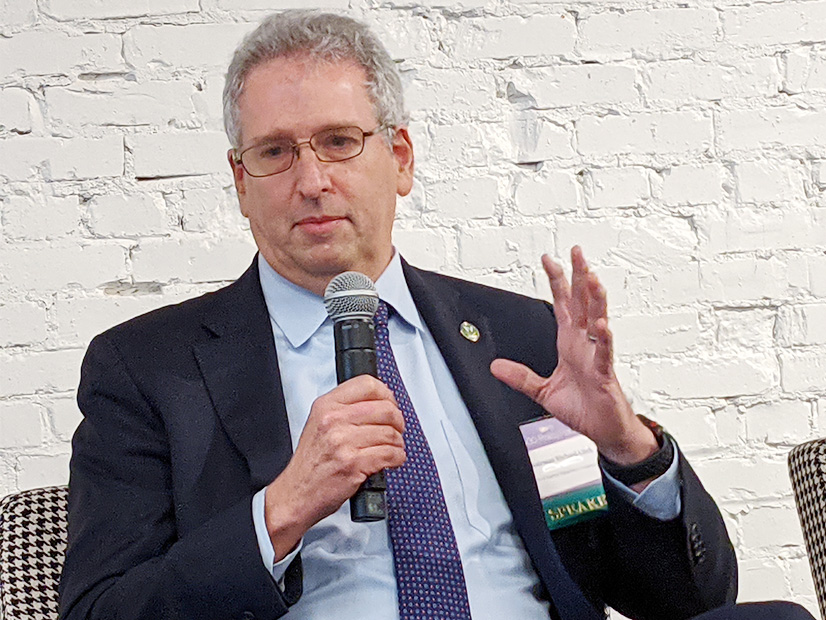WASHINGTON — Organized power markets have proven their worth over the past 20 years, but former FERC Commissioner Tony Clark says that doesn’t mean RTOs are the best choice for states in the West and Southeast seeking regional cooperation and reliability.
A senior adviser at Wilkinson Barker Knauer, Clark said RTO membership should be a state decision. “As we move forward, are there third ways that are going to develop? It seems like there kind of are in ways that make sense for those regions,” he said at the Solar Energy Industries Association 30×30 Policy Forum on Thursday. He cited current discussions about regional resource adequacy in the Pacific Northwest and the Southeast Energy Exchange Market recently approved by FERC.
“To RTO or not to RTO?” was the question posed to Clark, current FERC Chair Richard Glick and former Commissioner Suedeen Kelly at the SEIA conference. The solar trade association has set a goal of solar providing 30% of U.S. power generation by 2030, and organized markets will be critical in that effort, said moderator Gizelle Wray, SEIA’s director of regulatory affairs.
 Suedeen Kelly, Jenner & Block | © RTO Insider LLC
Suedeen Kelly, Jenner & Block | © RTO Insider LLC“Organized wholesale markets are the key to unlocking the cheapest, most reliable and affordable solar in the country,” Wray said. “We have seen time and time again that wholesale markets provide our members — independent power producers — with opportunities that are not afforded in vertically integrated states. At the moment, only organized wholesale markets are capable of providing the long-term certainty that clean energy businesses need to deploy solar and storage at scale.”
Glick said he favors RTOs and the benefits they provide in terms of economies of scale and regional power integration and reliability, but mandating their formation raises some thorny issues of jurisdiction. While he believes FERC does have the authority to mandate RTO membership for Western states, any such effort would not apply to municipal and public power utilities — such as the Bonneville Power Authority or the Los Angeles Department of Water and Power — which are outside of the commission’s authority.
“I think we need to encourage RTO development,” Glick said. “I think the time is now to act. We see the threats due to weather [and] the lack of resource sufficiency in certain areas. If [the states] don’t start working together, I think we’re going to see some calamitous issues.”
Kelly, partner at Jenner & Block, also underlined the advantages of RTOs — creating large, integrated transmission networks that foster reliability and eliminate unnecessary costs — but, like Clark, she saw the need for more flexible market structures. The West’s Energy Imbalance Market, while valuable, does not include a transmission component, she said, which makes it inefficient and difficult for “people in Santa Fe or Albuquerque to get an electron from California because they have to go through all the transmission [issues].”
“The states in the West come at this at a time when they’ve seen a history of how RTOs work,” Kelly said. “Most of those states want to see more renewables and a cleaner electricity mix. They have the opportunity to create an RTO that is not a cookie cutter, and my sense is that this FERC would be open to a construct that is not cookie cutter; rather [one] that is designed to achieve the goals” of those states.
Flexibility and False Dichotomies
The hundreds of gigawatts of solar and storage projects in interconnection queues across the country are, Wray said, “stuck in a perpetual waiting room because the transmission pathways to the markets are not being built.”
“This is not acceptable if we want to deploy a record amount of solar across the country,” she said. “We want FERC to reform the transmission planning process to include interconnection. Right now, renewable energy generators are left guessing which projects are needed and where, and these reforms will help to clarify the process and send the right market signals.”
Glick said changes to transmission planning are major priorities at FERC, with the Advance Notice of Proposed Rulemaking potentially providing solutions to bottlenecked interconnection queues. He expects a proposed rulemaking “by early next year,” he said.
As more renewables come onto the grid, flexibility, along with reliability, will be a key issue, Glick said. “There are certainly lots of ways to handle reliability, but how do you attract, how do you encourage flexibility?” he said. “Whether it’s gas or storage, how do you encourage, how do you incent [it] so it’s adequately compensated for the value it provides to the grid?”
 Tony Clark, Wilkinson Barker Knauer | © RTO Insider LLC
Tony Clark, Wilkinson Barker Knauer | © RTO Insider LLCWhile agreeing that thorough-going changes are needed, Clark argued that RTOs are not the only answer, particularly for reliability. “There’s sometimes a false dichotomy that’s presented to public policymakers, which is on one hand here, we have markets and free enterprise and competition and that’s RTOs, and on the other hand we have big, bad old [state] regulation,” he said.
Drawing on his experience at FERC and as a state regulator in North Dakota, Clark said, “There’s as much politics and rent seeking and regulatory capture in the RTO stakeholder processes as we ever dealt with in the cost-of-service regime. So, what you’re really dealing with is a couple of different administrative constructs, both of which can utilize myths of competition, or elements of competition, to try to drive outcomes that are good for consumers.”
States with vertically integrated utilities may be better at ensuring capacity than those with restructured retail power markets, Clark said. “The reason is because if you need to retain that sort of dispatchability in your capacity, you just go to your state commission [and] you build it into rates,” he said. “It’s going to be a trickier situation in most regions that have transitioned away from that.
“In my mind, Texas is kind of the canary in the coal mine on that issue,” he said, referring to last winter’s power outages in the state.
Getting Rid of Barriers
Kelly noted that the U.S. has experimented with a range of market-making strategies. The Public Utility Regulatory Policies Act helped kick-start the commercial and utility-scale solar market, she said.
Creating markets through incentives could be the “advantageous” result of the Build Back Better Act, with its $555 billion in funding for tax credits and other clean energy programs, she said.
But FERC’s creation of the RTOs and wholesale power markets was “revolutionary” for the U.S., she said. Beyond economies of scale and cost savings, the deployment of new technologies was also a core driver for the initial formation of RTOs, she said. But at that time, combined cycle natural gas plants were the “new guy on the block” facing market barriers from vertically integrated utilities, she said.
The caveat, Kelly said, is that state participation in RTOs is “optional, but an option that I think everyone should have available to them. The more buyers and the more sellers that can come together in one place, the better.”
Glick said FERC’s role is to remove barriers to markets, such as the commission’s orders opening wholesale markets to demand response (Order 745) and energy storage (Order 841).
“But we have a lot more to do in terms of hybrid resources,” such as solar and storage projects, he said. “Are there market rules out there discriminating against hybrid resources? Offshore wind is another area we need to take a look at; are there barriers there we need to get rid of? That’s the prime objective the commission needs going forward: getting rid of barriers.”


